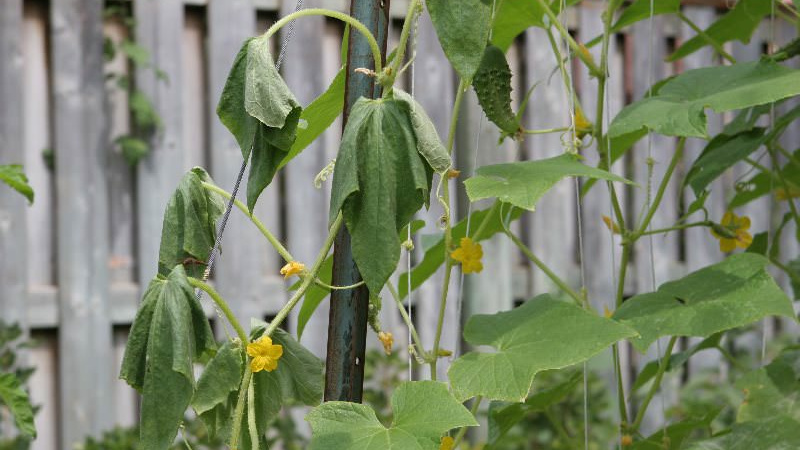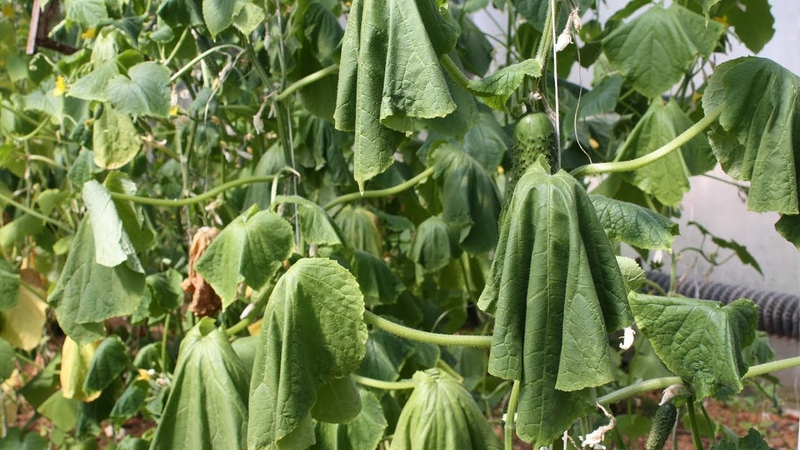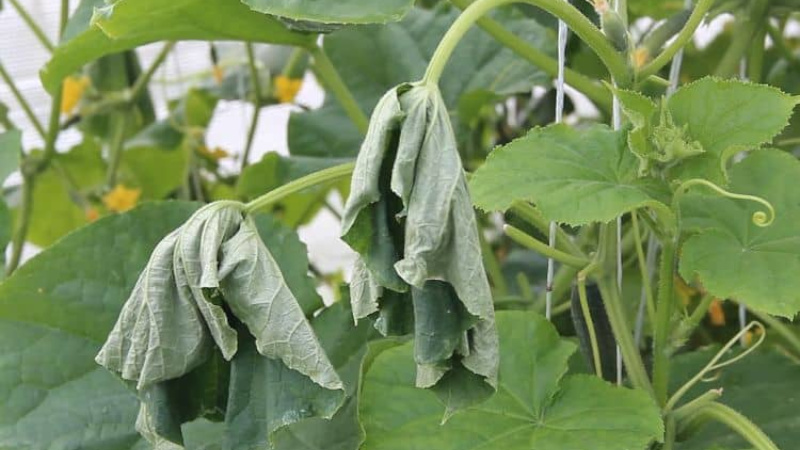How to be and what to do if cucumber leaves wither in a greenhouse: recipes for processing
The wilting of cucumber leaves, ovaries and whole lashes upset novice and experienced growers. Despite the same symptoms - loss of elasticity by the vegetative part, the reasons, as well as ways to correct the situation, may differ. Consider what to do if cucumber leaves wither in the greenhouse, and how to process them.
The content of the article
Why do leaves wither on cucumbers in a greenhouse and open field
The first thing to do when cucumber leaves wilt is abundant watering the beds... If this does not help, they look for the cause of the problem and promptly eliminate it.

Direct sunlight
Scourges grow and thrive best in shaded areas. In direct sunlight, delicate cucumber leaves will burn. It will not be possible to save heavily damaged bushes, they will die.
Thickened fit
Beginners often place cucumbers too close to each other to harvest more. Scourges always grow intensively, and plantings thicken. Such plants have nothing to breathe, they receive little light, nutrients from the soil. As a result, the leaves lose their elasticity.
Improper care and watering
Cucumbers have a delicate root system. Its slight damage during loosening, pinching or harvesting interrupts the flow of nutrients from the soil... Such bushes are depleted.
Excessive moisture in the soil leads to wilting of leaves: delicate roots cannot cope with the supply of nutrients from the wetland to the stems.
Lack of nutrients
Cucumber - demanding on nitrogen vegetable culture. Deficiency of this substance causes loss of turgor in leaves and stems, reduced growth, and absence of ovaries. Other vital nutrients for a vegetable are potassium, phosphorus and magnesium. Therefore, the culture is fertilized with urea, ash, superphosphate, chicken droppings, manure, charcoal, ash.
On a note! During the mass flowering of the bushes, they are not pollinated or sprayed - this will scare off pollinating insects and reduce the yield by 50–70%.
Sudden changes in temperature

Plants in open ground planted in June are more susceptible to wilting of stems and leaves due to a sharp drop in daily temperatures. The period of mass formation of ovaries and ripening of fruits in summer plantings occurs in August-September... During this time, the days are hot and the nights are cold, which makes the cucumbers freeze.
In greenhouses and greenhouses, such a problem is rarely encountered when cultivation agrotechnics are observed.
Fungal or bacterial diseases
Fungal spores and pathogenic bacteria multiply rapidly in protected ground and instantly infect the entire plantation... Frequent diseases of cucumbers in the greenhouse are fusarium, verticillosis, gray rot.
In the open field, fungi are less likely to infect the beds, but with prolonged rains, the risk of fungal wilting of cucumbers increases.
Pests
This is a dangerous, but easily diagnosed cause of wilting of cucumber leaves and stems in garden beds and indoors. An initial inspection of plants will help determine the type of insect by the nature of the damage:
- melon aphid leads to wilting of leaves, shedding of ovaries, slow growth of fruits;
- whitefly located on the back of the leaves, sucks the juice from the stems (three generations of the insect live on the plant at the same time - eggs, larvae and adults, similar to a white moth);
- spider mite a reddish color sticks to the leaves, envelops them in thick cobwebs and sucks out all the juices, which is why small white dots appear on the leaves;
- it is impossible to detect a rootworm nematode by the appearance of wilted bushes: it settles on the roots, which are covered with brown tubercles, and sucks juices from the plant.
Harmful insects not only mechanically damage the plant, but also transfer spores of fungal diseases.
How to understand why cucumbers wither

To accurately determine the causes of wilting, plants are examined primarily for the presence of diseases. With fungal infections, the color of the vegetative part at the bottom of the bush changes: fungal spores live in the soil, infect the lashes from the root collar and gradually make their way up.
Colonies of pests mainly cover the back of leaves and stems.
If in open ground the leaves lose their elasticity during the day, but in the evening they restore it, the reason is a lack of moisture. Similar symptoms are observed with sunburn, but then the outer surface of the leaves is covered in places yellow spots.
Attention! Lack of nutrients in the soil causes the bushes to wilt, as well as their excess.
If, after irrigation, the water does not go into the ground within an hour, this means that the soil under the cucumbers is swampy and needs mulching.

Rescue methods
In each case, measures to eliminate adverse factors are different. It is important to diagnose the cause of wilting in time in order to choose the most effective method:
- To prevent burns from direct sunlight, the beds are shaded or cucumbers are planted near fruit trees. Burns in a greenhouse are more dangerous: glass serves as a kind of magnifying glass and enhances the harmful effects of ultraviolet radiation. To prevent this during the day, the structure is covered with non-woven material.
- Excessively thickened beds in the open ground and in the greenhouse are promptly thinned out and stepson. Remove lower, dry, wilted and oversized leaves.
- In open beds, the soil is rarely waterlogged. Sometimes this happens in a greenhouse. To exclude waterlogging, drip dosed irrigation is organized in time. When weeding, they act carefully, they loosen the earth by no more than 5-7 cm.
- Threefold feeding in season will fully fill the need for nutrients in cucumbers. Mineral or organic fertilizers are applied on the 14th day after germination, with mass flowering and the formation of ovaries. Substances are added to the ground when watering or sprayed onto bushes.
- Late plantings in the open field are heated with dark stones in the aisles. During the day they will heat up intensively under the sunlight, and at night they will gradually give off heat to the plants.
- Sufficiently lit and well-ventilated bushes in the greenhouse rarely get sick. For the prevention of fungal infections, they are sprayed with "Trichodermin", "Planriz". Timely thinning and pinching, airing greenhouses, adherence to the irrigation regime help to fight massive injuries. Sick and sluggish lashes are treated from fusarium - "Fundazol", from verticillosis - "Maxim", "Topaz", from gray rot - "Rovral", "HOM" preparation.
- Cucumbers affected by insects are washed with a stream of water and sprayed with insecticides. "Fufanon", "Actellik" help from melon aphids, from whitefly - "Actellic", "Verticillin", "Pegasus", from spider mites - "Apollo", "Aktofit", "Vertimek", from gall nematode - chloropicrin.
Prevention and recommendations

If cucumbers wilt outdoors or in a greenhouse, follow these guidelines:
- according to the rules of crop rotation, the culture is not planted after cucumbers, zucchini, squash;
- the plants are planted according to the scheme indicated by the breeders on the package;
- mulching with dry material of waterlogged soil partially relieves roots from rotting;
- fertilizing with mineral and organic fertilizers alternate;
- in the greenhouse, plants are not fertilized with manure or dung: pests and diseases multiply in them instantly;
- bushes weakened due to drought are watered through a fine mesh under the root by hand, without touching the leaves;
- regular airing of the greenhouse and weeding in the open field significantly reduce the risk of fusarium infection.
Cucumbers are watered in the morning or evening. During the day, water droplets on the leaves will refract the sun's rays like a lens and cause burns.
Conclusion
Cucumber tops wither for various reasons - non-observance of cultivation techniques, diseases and pests, unfavorable natural factors. Regular watering and feeding, weeding, thinning of thickened plantings and treatment from insects, infections will eliminate the problem at the initial stage and will not allow it to worsen.